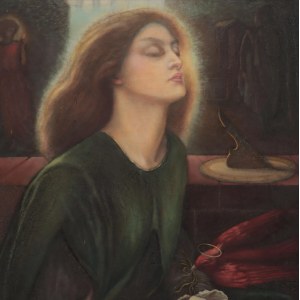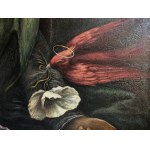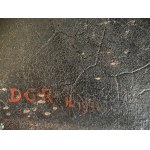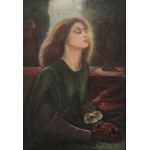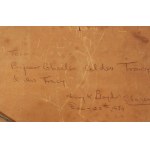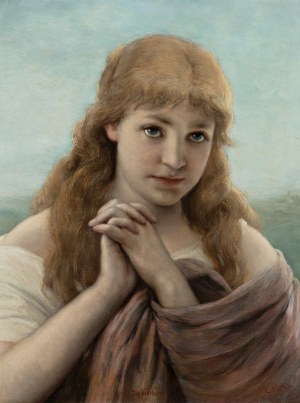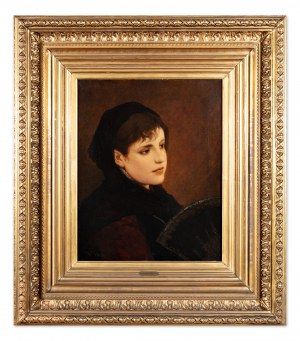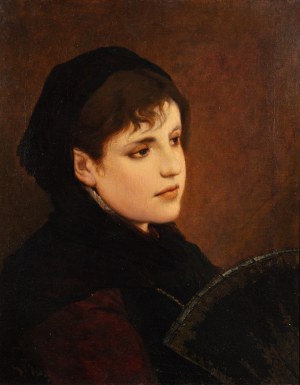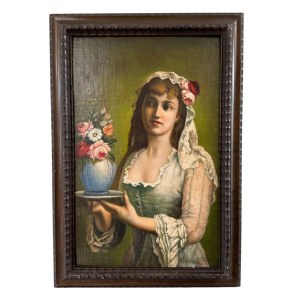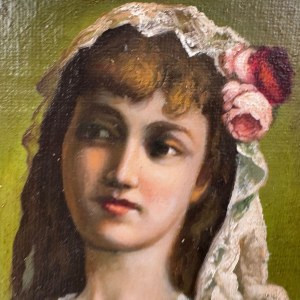Harvey K Llyod - Beata Beatrice, after Dante G. Rosetti.
Oil on canvas, pasted on board, 1934.
Dimensions: 72 x 52 cm,
On the back dedication:
To Professor Charles Adler Tracey and Mrs. Tracey.
Harvey K. Lloyd, Clearmont, NH. December 20, 1934.
Provenance:
The painting being sold is from the auction of the estate of Seymour Stein (1942-2023).
Seymour Stein died on April 2, 2023 in Los Angeles.
He was an American entrepreneur and music producer, co-owner of the Sire Records label
It is often forgotten that Dante Gabriel Rossetti (1828-1882), a British artist of Italian descent, was not only a painter, but also a poet. He created his own original poems, but also translated into English the works of Italian authors such as Dante Alighieri, Guido Cavalcanti and Giotto di Bondone. In 1864, a volume of his translated works was published under the title The Early Italian Poets. At the same time, the artist was working on the painting Beata Beatrix (Blessed Beatrix). This work is significant in the context of the painter's poetic work and his personal life, as Rossetti based the idea of the show on the parallel between his own experiences and those of the artist who was his great master and inspiration - Dante Alighieri. The painter even saw elements of kinship between the Italian poet's fate and his own. The painting intertwines the thread of a tragedy that affected both artists - the death of a beloved woman. For Beata Beatrix is a tribute to Elizabeth Siddal, Rossetti's wife, who, after giving birth to a stillborn child, in severe depression, committed suicide by taking too much laudanum. Rossetti intertwined the character of Siddal with that of Beatrice Portinari, with whom Dante was unhappily in love. Shortly after her untimely death (in 1290), Dante wrote a volume of poems, The New Life (La Vita Nuova, completed around 1292), which he dedicated to Beatrice, his idealized love for her and his sorrow after her death. It was the first poem Rossetti translated from Italian into English. Anyway, the creator of the Celestial Comedy was an important figure for the entire Pre-Raphaelite movement.
Beatrice, whom Rossetti gave the features of Elizabeth Siddal, is depicted in the foreground. She is seated slightly leaning forward, her hands folded in her lap. She is dressed in a long gray gown, over which she has a green cloak imposed. According to Frederic George Stephens, an art historian and critic and friend of Rossetti, the colors of the dress had their own symbolic meaning - referring to hope and sorrow, as well as love and life. The woman's head is raised as if she is directing it to the sun, capturing its last rays. Her pale gray face is framed by golden-red, straight, fluffy hair. Her eyes are closed, her mouth slightly open, her countenance is full of ecstasy. On the right side of the painting, right next to the hands of his beloved, the artist painted a golden-red bird resembling a pigeon. He is shown in flight, with a circular halo above his head. Such a depiction of him can be seen as a reference to the Holy Spirit, who was depicted in the form of a pigeon. In his beak he holds a flower of white poppies, which he is about to drop on Beatrice's hands. Despite being depicted in the color of love, the bird is a messenger of death, while the white poppy - an opiate flower - is its symbol, referring directly to the manner in which Siddal died. The inclusion of a pigeon-like bird in the composition has another dimension - Elizabeth was fondly called "Dove" by her husband.
Behind the figure of Beatrice, in the background, Rossetti showed the outlines of the cityscape of Florence, where the story of the affection Dante had for Beatrice is set. Florence is identifiable by the contours of the oldest bridge over the Arno River - Ponte Vecchio - in the vicinity of which Alighieri and his beloved lived with their family. On the right side of the painting, the artist painted the figure of Dante, who looks towards Love, who is shown opposite, on the left side of the painting. Love is depicted in the form of a red angel, holding a palm leaf in her hand. The two figures have not been rendered distinctly, they seem more like shadows. On the right side of the painting, as it were, between the figure of Dante and the pigeon hovering above Elizabeth's hands, is a sundial. The shadow cast by the clock's stationary hand falls on nine o'clock. This is another symbolic element of the composition. It refers to the moment of Beatrice's death, which occurred on June 9, 1290, precisely at nine o'clock.
Browns and greens dominate the painting, with patches of red being a stronger accent. The composition seems shrouded in fog, or rather a luminous golden glow that gives the scene a super-real dimension. Dante Gabriel Rossetti expounded the basic meanings of the painting in a letter to the work's first owner, Georgina Cowper-Temple, written in March 1871. As he reported, his intention was not to depict the death of Beatrice, but to show a moment of transition, a sudden spiritual transformation, a transfiguration. Elizabeth Siddal portrayed as Beatrice is shown in lethargy and trance, her pose and facial expressions are full of exaltation, spiritual rapture. Rossetti's model seems to be in a state of transition, on the border of worlds, of two parallel realities. She is no longer "here," but also not yet "there," on the other side.
Rossetti was preparing to paint the picture even before Siddal's suicide. Besides, from the beginning of the relationship he compared her to Dante's Beatrice. It was to be particularly powerful for the artist to realize that both women died in a similar way, a sudden, untimely death. Elizabeth, a fashionista's assistant, spotted by one of Rossetti's friends in a hat store, became the painter's muse and lover. Already in a relationship with the artist herself, she also betrayed some interest in painting and poetry. She even won the admiration of John Ruskin, the most important British art critic of the time, who looked with appreciation on the achievements of the Pre-Raphaelites, a brotherhood of which Rossetti was a founding member. Siddal suffered from fits of uncontrollable anger and episodes of deep depression. She suffered from tuberculosis and was heavily dependent on painkillers. She and Rossetti were in an informal relationship for a long time; the artist married her only when her health seriously deteriorated.
In the last two decades of his life, Rossetti created deeply symbolic paintings imbued with autobiography, the form and meanings of which perfectly resonated with his personality: a romantic and neurotic living with guilt over the death of his wife, addicted to alcohol and chloral (sleeping pills), sensitive to any criticism. In the painter's earlier works, the figure of the woman, who often acquired the features of Siddal, functioned in narrative contexts, in later works - she was usually an independent figure: even more demonic, strong, ecstatic. Rossetti's painting manner also changed in the late 1850s. The artist, initially fascinated by the art, especially painting, of the early Latin Middle Ages, was one of the members of the Pre-Raphaelite Brotherhood who most readily operated with forms, motifs and themes relating to the Middle Ages in his work. He was also inspired by the artistic experience of the artists known as Nazarenes, gathered in the circle of another artistic brotherhood - the Brotherhood of St. Luke, founded in Vienna in 1809. In the late 1850s Rossetti abandoned manneristic, contoured forms, the elements of the depicted world of his paintings became a bit more "bodily", full, but often at the same time imbued with an unreal, visionary element.
The Pre-Raphaelite Brotherhood was formed in 1848 by students of the Royal Academy - William Holman Hunt, Dante Gabriel Rossetti and John Everett Millais - as a gesture of opposition to the teaching methods and art promoted by the Academy and considered official. The Brotherhood initially received a lot of criticism, and were even ridiculed for their anti-academic stance and the way they painted - handling detail, bright, luscious colors, and drawing on little-known themes from local tradition and the Bible. By the mid-1950s, however, the artists had already gained a following and enjoyed increasing public acclaim. This success, however, was not conducive to maintaining the unity of the group. Each of the Pre-Raphaelites basically went his own way. Rossetti was the member of the group who best fulfilled his role as an artistic outsider. His works, at first manneristically referring to the Middle Ages, then visionary depictions of women, even "baroque" in mannerism, were copied and interpreted by dozens of followers of the brotherhood. To a large extent, they are what are associated with the group's paintings /Izabela Kopania/.



